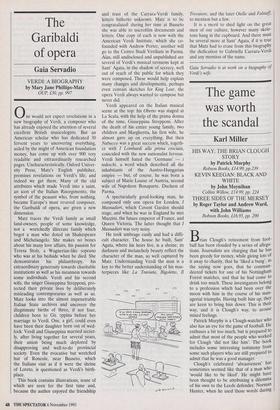The Garibaldi of opera
Gaia Servadio
VERDI: A BIOGRAPHY by Mary Jane Phillips-Matz OUP, £.30, pp. 997 One would not expect revelations in a new biography of Verdi, a composer who has already enjoyed the attention of several excellent British musicologists. But an American scholar who has dedicated 30 fervent years to uncovering everything, aided by the might of American foundation money, has come up with over 900 very readable and extraordinarily researched pages. Uncharacteristically, Oxford Univer- sity Press, Matz's English publisher, promises revelations on Verdi's life, and indeed we get them. Many of the old attributes which made Verdi into a saint, an icon of the Italian Risorgimento, the symbol of the peasant who, from nothing, became Europe's most revered composer, the Garibaldi of opera, are given a new dimension.
Matz traces the Verdi family as small land-owners, people of some knowledge, not a wretchedly illiterate family which begot a man who doted on Shakespeare and Michelangelo. She makes no bones about his many love affairs, his passion for Teresa Stolz, a Wagnerian-like soprano who was at his bedside when he died. She demonstrates his philanthropy, his extraordinary generosity towards charitable institutions as well as his meanness towards some individuals. Verdi and his second wife, the singer Giuseppina Strepponi, pro- tected their private lives by deliberately misleading contemporaries as well as us. Matz looks into the almost impenetrable Italian State archives and uncovers the illegitimate births of three, if not four, children born to Git. eppina before her marriage to Verdi. One, a girl, could even have been their daughter born out of wed- lock: Verdi and Giuseppina married secret- ly, after living together for several years, their union being much deplored by disapproving and well-to-do provincial society. Even the evocative but wretched hut of Roncole, near Busseto, which the Italians visit as if it were the shrine of Loreto, is questioned as Verdi's birth- place, This book contains illustrations, some of which are seen for the first time and, because the author enjoyed the friendship
and trust of the Carrara-Verdi family, letters hitherto unknown. Matz is to be congratulated: during her time at Busseto she was able to microfilm documents and letters. One copy of each is now with the American Verdi Institute, which she co- founded with Andrew Porter, another will go to the Centro Studi Verdiani in Parma. Alas, still undisclosed and unpublished are several of Verdi's musical revisions kept at Sant' Agata, in the shadow of secrecy, well out of reach of the public for which they were composed. These would help explain many changes and developments, perhaps even contain sketches for King Lear, the opera Verdi always wanted to compose but never did.
Verdi appeared on the Italian musical scene at the top: his Oberto was staged at La Scala, with the help of the prima donna of the time, Giuseppina Strepponi. After the death of his entire young family, two children and Margherita, his first wife, he almost gave up on everything. But then Nabucco was a great success which, togeth- er with I Lombardi alla prima crociata, coincided with the new nationalist fervour. Verdi himself hated the `Germans' — i tedeschi, a word which described all the inhabitants of the Austro-Hungarian empire — but, of course, he was born a subject of Marie Louise of Austria, second wife of Napoleon Bonaparte, Duchess of Parma.
A spectacularly good-looking man, he composed only one opera for London, I Masnadieri, which Covent Garden should stage, and when he was in England he met Mazzini, the future emperor of France, and Queen Victoria. The latter thought that I Masnadieri was very noisy.
He took umbrage easily and had a diffi- cult character. The house he built, Sant' Agata, where his heirs live, is a shrine; its darkness and melancholy beauty reflect the character of the man, so well captured by Matz. Understanding Verdi the man is a key to the better understanding of his mas- terpieces like La Traviata, Rigoletto, 11 Trovatore, and the later Otello and Falstaff, to mention but a few.
It is a merit to shed light on the great men of our culture, however many skele- tons hang in the cupboard. And there must be several more at Sant' Agata, if it is true that Matz had to erase from this biography the dedication to Gabriella Carrara-Verdi and any mention of the name.
Gaia Servadio is at work on a biography of Verdi's wife.










































































 Previous page
Previous page